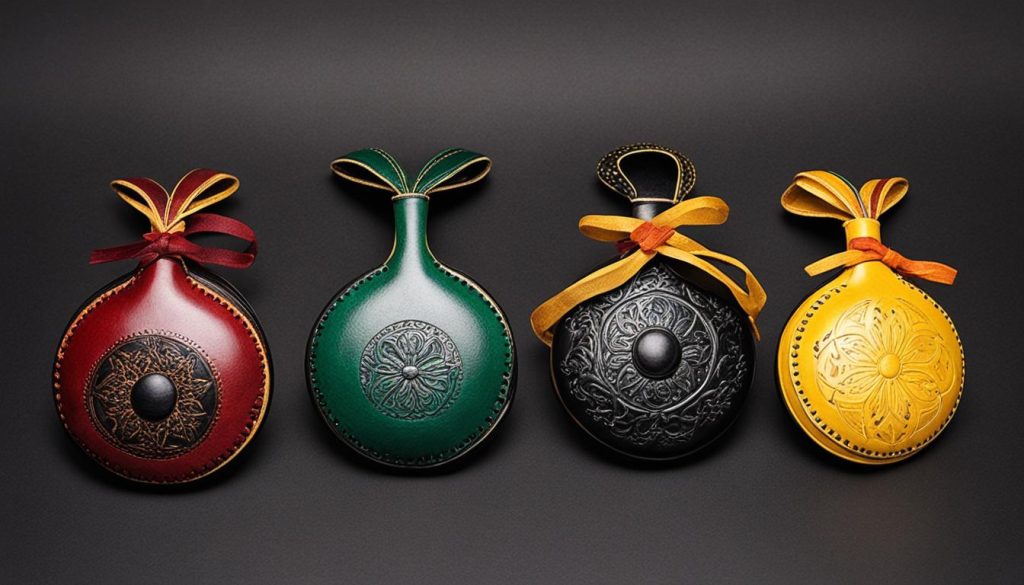The origin of Castanets, the traditional percussion instrument, has a rich history that dates back over 3000 years.
They were originally invented by the Phoenicians for religious ceremonies and eventually spread throughout the Mediterranean.
Castanets took root in Spain during the Middle Ages due to trade in the Iberian peninsula and later became synonymous with the country’s culture.
The Spanish word for castanet is “castanuelas,” and they are traditionally made from chestnut or hazelwood.
Castanets are always played in pairs, with the left-handed one called the “macho” and the right-handed one called the “hembra.”
They have a distinct role in flamenco dance, thanks to the influence of Antonia Mercé y Luque, also known as “La Argentina.”
Despite their association with flamenco, castanets have been used in classical music and are part of the cultural heritage of Spain.
Evolution and Cultural Significance of Castanets

The origin of castanets can be traced back to the Phoenicians, but their evolution and cultural significance extend well beyond their initial invention.
Castanets have been used in various styles of Spanish music, including classical compositions by artists like Santiago de Murcia. They have also been part of the folklore in countries like Portugal and numerous Latin American countries.
In flamenco, castanets play a vital role in regional dances such as sevillanas and fandangos. They are known for their unique sound and rhythmic richness, adding a pulsating energy to the performance.
Castanets can be traced back to ancient times when they were crafted from materials like bone, wood, and even ivory. These ancient castanets were precursors to the modern castanets we see today.
Over the years, castanets have evolved not only in terms of materials but also in construction.
Traditionally, castanets were made from wood, often chestnut or hazel, but now modern materials such as pressed cloth and fiberglass are used. Fiberglass castanets offer not only durability but also the ability to produce different tones and effects.
Despite the evolution in materials, castanets have retained their cultural significance. They have become inseparable from flamenco music and dance, symbolizing the traditional practices and heritage of Spain.
Castanets continue to captivate audiences with their distinct sound and play a significant role in preserving and celebrating the vibrant cultural traditions associated with flamenco.
The Cultural Significance of Castanets in Spain
The cultural significance of castanets in Spain is deeply rooted in history and tradition. These percussion instruments have become iconic symbols of Spanish music and dance, particularly within flamenco.
Castanets are seen as an expression of national identity and an essential part of Spain’s cultural heritage.
The rhythmic patterns created by castanets in flamenco music are intricate and unique, adding a layer of complexity to the performances.
In regional dances like sevillanas and fandangos, the use of castanets enhances the lively and passionate nature of the dance, captivating both the performers and the audience.
Castanets have also influenced the development of Spanish classical music. Composers like Manuel de Falla and Isaac Albéniz incorporated the distinctive sound of castanets into their compositions, showcasing the instrument’s versatility and bridging the gap between classical and folk music traditions.
Through their evolution and cultural significance, castanets have come to represent the soul and spirit of Spanish music and dance.
They continue to be cherished and embraced by performers and enthusiasts alike, serving as a powerful connection to Spain’s rich artistic heritage.
Castanets in Contemporary Music and Dance
While the origin of castanets has a long and storied history, they continue to exert a significant influence on contemporary music and dance. In orchestral compositions, castanets are frequently featured, adding unique sound effects and rhythmic accents to the overall musical experience.
Renowned composers such as Leonardo Balada and Helmut M. Timpelan have even written solo works specifically for castanets and orchestra, showcasing the instrument’s versatility and ability to captivate audiences.
When it comes to flamenco, castanets remain an integral part of performances, serving as a means to evoke a culturally authentic Spanish atmosphere.
Today, castanets can be seen not only in traditional flamenco performances but also in modern interpretations of Spanish music and dance.
Whether it’s the rich history and origins of castanets or their seamless integration into contemporary music and dance, their influence and tradition continue to thrive.
The sound and rhythm that castanets bring to various musical compositions and performances showcase their enduring relevance in the world of music and dance, solidifying their place as an iconic instrument.
